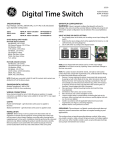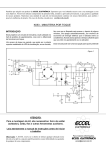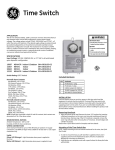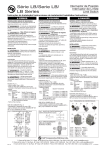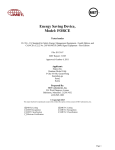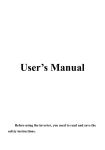Download GE 15136 Instructions / Assembly
Transcript
Digital Time Switch SPECIFICATIONS Input Voltage: 120 VAC, 208/240 VAC, or 277 VAC in all units based upon dipswitch configuration. Switch Rating: DPDT Models Normally Open Contacts 40A Resistive, 120-277Vac. 30A General Purpose, 120-277Vac. 20A Resistive, 30Vdc 1 HP, 120Vac ; 2HP, 240Vac ; 20A Ballast, 120-277Vac. 15A Tungsten, 120Vac 5.4A Tungsten, 208-277Vac. 800VA, Pilot Duty, 120Vac. 720VA, Pilot Duty, 240-277Vac. TV-5, 120Vac Normally Closed Contacts 30A Resistive, 120-277Vac 15A General Purpose, 120-277Vac 15A Resistive, 30Vdc 20A Ballast, 120-277Vac 1/4HP, 120Vac; 1/2HP, 208-240Vac. 290VA, Pilot, 120Vac. 360VA, Pilot, 208-240Vac. NOTE: If loads are connected to both NC and NO contacts, both contacts are derated to 67% of the above values. ENVIRONMENTAL RATINGS Ambient Temperature: –40F to 130F Humidity: 0-95% RH, Non-condensing WIRING CONNECTIONS Screw clamp terminals for up to 2, 8 AWG wires per position. For supply connections, use 8AWG or larger wires suitable for at least 105° C. Use copper conductors only. Lights Power LED (Orange) – Light illuminates when power is applied to the timer Status LED (Green) – Light illuminates when power is applied to load. INSTALLATION CAUTION: Before wiring or service, power to this time switch and the equipment it controls must be turned off. Turning off the timer switch only will not prevent a shock hazard. Replace cover plate within housing before supplying power to time switch. Installation should be performed by a licensed electrician only. Before installing this product read all instructions carefully. Remove protective cover panel within time switch housing by removing screws located below timer face. Dipswitch Configuration WARNING: Failure to properly configure the dipswitch will result in damage to the unit and void the warranty! Before installing and wiring the GE Time Switch, proper configuration must be selected. This is accomplished as follows: 120VAC ON OFF 208~240VAC ON OFF 277VAC (Default) ON OFF ALL ON 1 & 4 OFF 2 & 3 ON ALL OFF NOTE: For outdoor locations, rain tight or wet location conduit hubs that comply with requirements of UL 514B (standard for fittings for conduit and outlet boxes) must be used. 1. To mount the box, remove the timer mechanism. Push the latch at the top of the timer mechanism. The mechanism will release and pull out of box. 2. Select knockouts to be used. Remove the inner 1/2” knockout by inserting a screwdriver in the slot and carefully punch knockout loose. Remove slug. If the 3/4” knockout is required, remove the outer ring with pliers after removing the 1/2” knockout. Smooth edges with file if necessary. 3. Place enclosure in desired mounting location and mark the three mounting holes. 4. Drill holes for #8 screws using 1/8” drill bit, start screws in holes. 5. Place enclosure over screws and tighten screws. 6. Connect conduit hubs to conduit before connecting the hubs to the enclosure. After inserting hubs into enclosure, carefully tighten hub lock nut. Do not over-tighten. 7. Install in accordance with all applicable National and Local code requirements. See Figure 1 and wiring diagrams. 8. To place the timer mechanism back in the metal box timer first hold top of the timer mechanism. Slide the plastic case into the metal box latches in the center of the metal box. Push the top of the timer mechanism until the metal latch snaps into place. GROUNDING: This enclosure has a grounding block on the bottom/ inside of the timer box. Screw in all ground wires to the ground block. A pool application does not require bonding. This enclosure does not provide grounding between conduits. When using non-metallic conduit or cable, connect the ground wires of all cables together with a wire nut. When metallic conduit is used, use grounding type bushings and a jumper wire between each conduit. 15136 Figure 1 MIN. MINIMUM MAX. COPPER LOAD INSULWIRE SIZE (AMP) ATION TEMP(°C) (AWG) 14 12 10 8 15 20 30 40 60 60 60 105 75°C INSULATION MAX. MOTOR LOAD (HP) SINGLE PHASE 120 V. 240 V. 1/2 1 2 - 2 2 1/2 3 5 PRESSURE PLATE 3 PHASE 208 V. 240 V. N/A TERMINAL SCREW MAKE SURE WIRE INSULATION CLEARS PRESSURE PLATE N/A Typical Wiring Diagrams—SPDT Typical Wiring Diagrams—DPDT Timer and Load, Same Voltage Wired as Single Throw 120V Timer, 200/240/277V Load Double Break Wired as Single Throw T T TIMERN NC TO POWER SUPPLY TIMERN H TO 120V LINE OC OM TO LOAD CN TO 200/240/277V LINE LOAD N Timer and Load, Different Voltage Wired as Single Throw O COM NC2 NO2 COM2 120V Timer, 120V Load and 24V Load Wired as Single Throw T T TIMERN CN OC OM TIMERN H TO 120V LINE N N TO LOAD H TO POWER SUPPLY 2 LOAD TO POWER SUPPLY 1 120V Two Speed Fan Wired as Double Throw T CN O COM NC2 NO2 COM2 TO 24V LINE LOAD 200/240/277V Timer, 200/240/277V Load, Double Break Wired as Single Throw T H N TIMERN CN OC OM HIGH LOW COM L1 Field Wiring Timer Internab Wiring L2 TO 120V LINE TIMERN CN O COM NC2 NO2 COM2 LOAD Operating Instructions (Reset) H(Hours Setting) M(Minutes Setting) Day (Days Setting) LCD (Function Figures) Clock (Current Time Setting) Timer (9 Programs Setting) Override (Manual ON/OFF Switched) Basic Settings Initial Set Up: 1. Push the Reset button “R” before programming to clear out any settings. Once the “Reset” button is pressed the screen will begin to flash. A paperclip may be needed for this step. (If the “Reset” button is shown down, use a paper clip to maneuver it until it pops back up. The screen will flash if the button is in its proper position) 2. Press the “Clock” button and the screen will stop flashing and be ready for programming. Setting the Current Time: 1. 2. 3. 4. 5. Press and Hold the “Clock” button during the entire setting. Press the “H+” button to set the hours. Press the “M+” button to set the minutes. Press the “Day” button to set the day of the week. Release the “Clock” button. Programming ON/OFF Settings: 1. Press the “Timer” button once and the TIMER 1 ON - - : - - appears. 2. Press the “H+” and “M+” button to set the hours and minutes to the desired time. 3. Press the “Day” button to select the day(s) the setting will be active. Refer to the Multiple Weekday Group below to see the available settings. 4. Press the “Timer” button to store the setting and proceed to the next setting TIMER 1 OFF - - : - -. 5. Repeat steps 1-4 to program the remaining ON/OFF times setting options (9 Total ON/OFF settings). Once completed press the “Clock” button to return to the main display. Multiple Weekday Groups: Apart from individual week days, pressing the “Day” button also selects multiple day combinations such as: ‧ Monday thru Friday ‧ Tuesday & Thursday & Saturday ‧ Saturday & Sunday ‧ Monday thru Wednesday ‧ Monday thru Saturday ‧ Thursday thru Saturday ‧ Monday & Wednesday & Friday ‧ Monday thru Sunday After setting a single day or a multi-day-combination the programmed timer settings will be carried out on each of the week-days at the same time. 15136 Programming Countdown Operation: 1. Press the “Timer” button replacing to scroll through the 9 ON/OFF settings to get to the ON C setting. 2. Press the “Override” button to select whether the timer will turn ON or OFF during teh countdown period. 3. Press the “H+” and “M+” buttons to set the hours and minutes of the countdown. 4. Press the “Clock” button to store the setting and return to the current time display. See the diagram below for more information. Activate the Countdown Feature: 1. Press the “Clock” and “Override” buttons at the same time to start the countdown function. 2. Press the “Override” button to pause and continue the countdown function. 3. Press the “Clock” button to go view the current time display. Summer Time Feature (DST): Press the “H+” and “M+” buttons for 3 seconds to advance the current time 1 hour, SUMMER should appear on the display. Repeating this process will decrease the time by 1 hour and SUMMER will disappear. Power Back Up Feature: In the event of a power failure, the timer will retain its settings for an estimated 3 months assuming the power back up is fully charged. Button Lock: This function allows the user to lock the buttons so that they are not accidentally pressed. 1. Press and HOLD the “Clock” button for more than 5 seconds. An “ “ icon will appear on the display. The buttons are now locked. To unlock the buttons repeat this step. Manual Override: The timer comes with the ability to control the ON and OFF function while the timer is deactivated. Press and Hold the “Override” button to switch between timer mode and manual mode. Timer mode will be indicated by an A next to the ON or OFF. When the timer is in manual mode (not controlled by timer) the A will not appear on the display. Any time the “A” is displayed the timer is in control and will always follow the programmed settings (even if it is temporarily deactivated by moving from ON to OFF or OFF to ON). Random, ON/OFF Setting: This feature allows the timer to switch ON and OFF at random times. It is particularly useful in helping to prevent burglary as the timer is not switching ON and OFF at regular times. The programmed settings will be executed in a random delay varying within 30 minutes. This function will only operate if one or more programmed switching commands are set. 1. Press both “Day” and “H+” buttons at the same time. The display will show the “TIMER” symbol blinking. The random feature is now activated. 2. To turn the random feature off repeat step 1. Note: “ “ Flashing: the timer is in the manual mode with key lock. “ “ Not flashing: the timer is in the timer mode with key lock. Lockout a Programmed Setting (Skip a Setting): 1. Press the “Timer” button repeatedly to scroll to the setting that needs to be skipped. 2. Press the “Override” button to lockout the time setting. The display will display “H I : d E” and lock the hours and minutes setting. 3. Press the “Override” button again to recall the setting time. This Function (Will not work for Lockout Countdown feature) 15136



